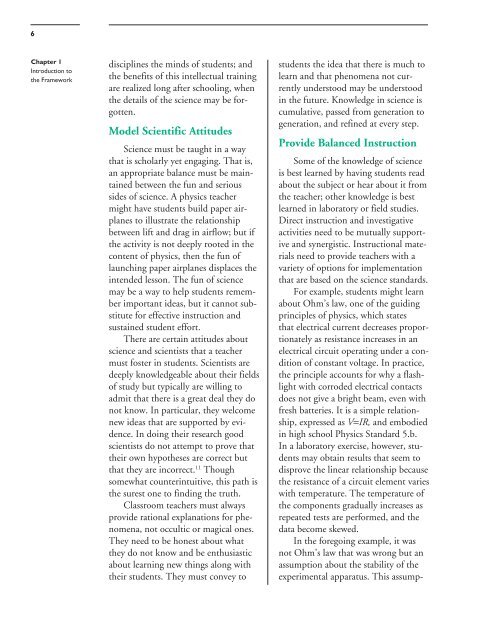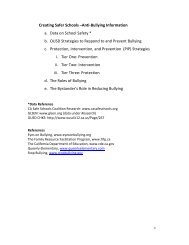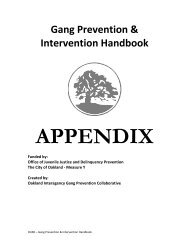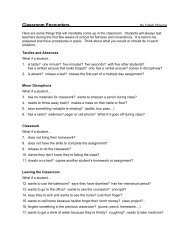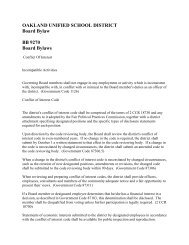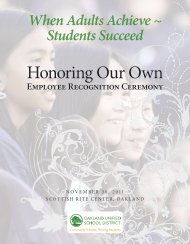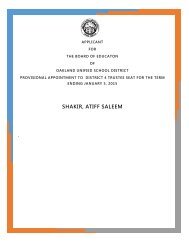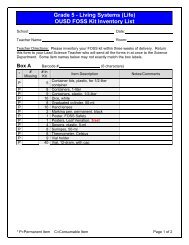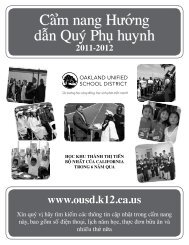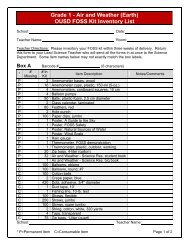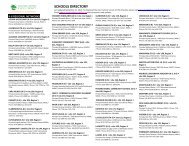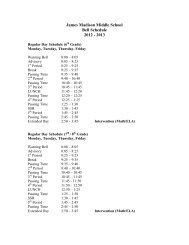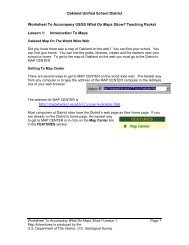Science Framework, part 1 - Free Downloads (CA Dept of Education)
Science Framework, part 1 - Free Downloads (CA Dept of Education)
Science Framework, part 1 - Free Downloads (CA Dept of Education)
- No tags were found...
Create successful ePaper yourself
Turn your PDF publications into a flip-book with our unique Google optimized e-Paper software.
6Chapter 1Introduction tothe <strong>Framework</strong>disciplines the minds <strong>of</strong> students; andthe benefits <strong>of</strong> this intellectual trainingare realized long after schooling, whenthe details <strong>of</strong> the science may be forgotten.Model Scientific Attitudes<strong>Science</strong> must be taught in a waythat is scholarly yet engaging. That is,an appropriate balance must be maintainedbetween the fun and serioussides <strong>of</strong> science. A physics teachermight have students build paper airplanesto illustrate the relationshipbetween lift and drag in airflow; but ifthe activity is not deeply rooted in thecontent <strong>of</strong> physics, then the fun <strong>of</strong>launching paper airplanes displaces theintended lesson. The fun <strong>of</strong> sciencemay be a way to help students rememberimportant ideas, but it cannot substitutefor effective instruction andsustained student effort.There are certain attitudes aboutscience and scientists that a teachermust foster in students. Scientists aredeeply knowledgeable about their fields<strong>of</strong> study but typically are willing toadmit that there is a great deal they donot know. In <strong>part</strong>icular, they welcomenew ideas that are supported by evidence.In doing their research goodscientists do not attempt to prove thattheir own hypotheses are correct butthat they are incorrect. 11 Thoughsomewhat counterintuitive, this path isthe surest one to finding the truth.Classroom teachers must alwaysprovide rational explanations for phenomena,not occultic or magical ones.They need to be honest about whatthey do not know and be enthusiasticabout learning new things along withtheir students. They must convey tostudents the idea that there is much tolearn and that phenomena not currentlyunderstood may be understoodin the future. Knowledge in science iscumulative, passed from generation togeneration, and refined at every step.Provide Balanced InstructionSome <strong>of</strong> the knowledge <strong>of</strong> scienceis best learned by having students readabout the subject or hear about it fromthe teacher; other knowledge is bestlearned in laboratory or field studies.Direct instruction and investigativeactivities need to be mutually supportiveand synergistic. Instructional materialsneed to provide teachers with avariety <strong>of</strong> options for implementationthat are based on the science standards.For example, students might learnabout Ohm’s law, one <strong>of</strong> the guidingprinciples <strong>of</strong> physics, which statesthat electrical current decreases proportionatelyas resistance increases in anelectrical circuit operating under a condition<strong>of</strong> constant voltage. In practice,the principle accounts for why a flashlightwith corroded electrical contactsdoes not give a bright beam, even withfresh batteries. It is a simple relationship,expressed as V=IR, and embodiedin high school Physics Standard 5.b.In a laboratory exercise, however, studentsmay obtain results that seem todisprove the linear relationship becausethe resistance <strong>of</strong> a circuit element varieswith temperature. The temperature <strong>of</strong>the components gradually increases asrepeated tests are performed, and thedata become skewed.In the foregoing example, it wasnot Ohm’s law that was wrong but anassumption about the stability <strong>of</strong> theexperimental apparatus. This assump-


